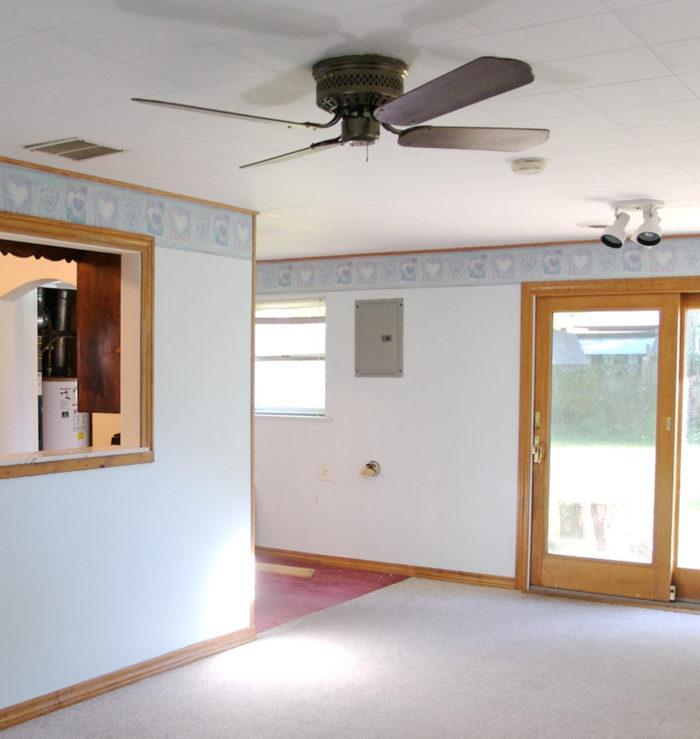
Image Credit: Image #1: Kevin Marsh
Image Credit: Image #1: Kevin Marsh This ceiling fan label shows a very low efficacy, mostly because the blades are a short 24".
Image Credit: Image #2: Energy Vanguard This Energy Star ceiling fan gives more data about its efficacy. Notice that the table shows the efficacy for high, medium, and low speeds, not just high speed.
Image Credit: Image #3: Energy Vanguard Don't go by the recommendations in this Energy Star ceiling fan sizing chart! If you do, you may buy a fan that costs you twice as much as it should.
Image Credit: Image #4: Energy Star The most energy-efficient ceiling fan listed in the Energy Star spreadsheet is the Haiku by Big Ass Fans.
Image Credit: Image #5: Big Ass Fans
A little over a decade ago when I was building a house and buying a bunch of ceiling fans, it wasn’t so easy to figure out which fans were energy efficient and which weren’t. That’s not the case anymore because every ceiling fan now has a label on the package that tells you how much air movement you can expect for each watt of electricity you put into the fan.
What is efficacy?
Air flow, whether you’re talking about duct systems, bath fans, heat recovery ventilators, or ceiling fans, is measured in cubic feet per minute (in the U.S., of course, where we use those annoying imperial units). We usually abbreviate and simply call it cfm. The higher the number, the more air is moving.
Energy usage can be a bit confusing because of the whole rate versus cumulative quantity issue. The watt is the unit for the rate of energy consumption. The kilowatt-hour is the unit for the quantity of energy consumed.
Efficiency of any type is generally an output divided by an input. If we are comparing an energy input with an energy output, we report the result as an efficiency rating. If the output we are looking at is not an energy output, however, we use the term “efficacy.” Heating and cooling system ratings generally refer to efficiency: AFUE, SEER, HSPF… On the other hand, light bulb ratings compare brightness (the output) with energy (the input); thus we speak of light bulb efficacy, not efficiency.
To measure how well a ceiling fan does its job, the output that we are measuring is not an energy output; it’s air flow. So, as with light bulbs, we’re talking about efficacy, not efficiency.
Just how efficacious are ceiling fans?
We can go with either rates or quantities when we look at efficacy of ceiling fans. For example, we could give the efficacy in terms of the rate of air flow per unit time (cfm) divided by the energy use per unit time (watts), which in fact is what we do. Most ceiling fan packages show a box with three numbers, all specified for the fan running at high speed: the air flow (cfm), the rate of electricity use (watts), and the air flow efficacy (cfm/watt). You can see this in the labels shown below.
I went down to the big box store a while back and started looking at ceiling fan packages. The range of efficacies that I saw in the store ran from 35 cfm/watt on the low end to 106 cfm/watt at the high end. Most of the fans were in the 60 to 75 cfm/watt range. One factor that affects this number is how big the fan is. That 35 cfm/watt fan was a tiny 24″, whereas the 106 cfm/watt fan was 52″. The range of efficacies for the larger fans, according to the label shown below, is 51 to 176 cfm per watt for fans that are 49″ to 60″.
A few of the boxes had more energy data than the simple box shown above. They also happened to be the fans that had the Energy Star label. In addition to showing the numbers for high speed, they also showed the air flow, energy consumption, and efficacy for low and medium speeds.
If you look carefully at the two labels below, you’ll see one other thing there that I saw on nearly every label: a money saving tip. Here it is: “Turn off fan when leaving room.” That’s right. Fans don’t cool the space. They cool people. They actually heat the space because the motor gives off heat, and the stirring up of the air results in heating, too. So, turn off those ceiling fans!
Size matters
Choosing a fan with a high efficacy is only part of what you need to do to get an energy efficient ceiling fan. I bought a new ceiling fan recently and noticed that many of them gave sizing recommendations. And many of those recommendations were not ideal.
All else being equal, efficacy increases when you increase the blade length. Think about it. A motor causes the blades to move through the air. Because of the way they’re slanted with respect to the plane of rotation, they push air. To get more air movement, you can do two things (assuming you’re not changing the room or fan position): Increase the fan speed or increase the blade size. Both increase the energy usage, but increasing the fan speed increases the energy usage a lot more than increasing the blade size.
What that means, if you’re looking for a fan that does its job as efficiently as possible, is that you should get a bigger fan than some of the boxes recommend. To make matters even more confusing, the Energy Star page on ceiling fan sizing recommends installing smaller, less efficent fans than you really should. You can see their sizing chart in the images below.
If I’d gone with their recommendation, I would have bought a 44″ ceiling fan since the bedroom I installed it in is about 160 square feet. The efficacy for a typical 44″ ceiling fan at that store was about 60 cfm/watt at high speed. The 52″ fan I bought gets 81 cfm/watt at high speed.
Even better is that I can run the 52″ fan at medium speed to get about the same air flow as the 44″ fan at high speed. The efficacy comparison then is 117 cfm/watt for the 52″ fan versus 60 cfm/watt for the 44″ fan. That means I’ll use about half the energy to get the same air flow. In addition to saving energy, fans are also quieter when they run at lower speeds.
Use the Energy Star spreadsheet
If you want to stick to Energy Star certified ceiling fans, you need to go to the Energy Star website and download their ceiling fan spreadsheet (look for the link in the sidebar on the Energy Star website). The Excel format allows you to sort by brand, size, efficacy (at high, medium, or low speed), or any of several other parameters. For example, if you know you want a 52″ ceiling fan with a light kit, you can sort the whole list to view only those that meet your criteria. It’s a great resource.
One interesting thing you’ll find when you sort is that the most efficient Energy Star ceiling fans are made by a company with the audacious name of Big Ass Fans. Their Haiku residential fan, shown below, is gorgeous and has efficacies that range from 846 to 1018 cfm/watt on low speed and 422 to 549 cfm/watt on high speed. They blow most of the others away! (Ha ha ha.)
Another brand that comes close is Aeratron, with its E502-SL and E503-SL models. They come in at 608 to 655 cfm/watt on low speed and 357 to 383 cfm/watt on high speed. If you’re looking for the really high efficacy ceiling fans, though, you probably won’t find them at your local big box store. You also won’t find them at big box store prices.
Three rules for getting the most energy efficiency our of your ceiling fan
If you want to get the most out of your ceiling fans, there are only three simple rules you need to know:
- Get a fan with a high efficacy
- Get the biggest fan you can
- Turn off fans when you’re not in the room
On the sizing recommendation, just make sure you meet all the specified clearances. Then you can get the biggest one that makes sense for the room.
Do your research, follow these three rules, and your new ceiling fans will help you be more energy efficient in your home, not less.
Allison Bailes of Decatur, Georgia, is a speaker, writer, energy consultant, RESNET-certified trainer, and the author of the Energy Vanguard Blog. You can follow him on Twitter at @EnergyVanguard.
Weekly Newsletter
Get building science and energy efficiency advice, plus special offers, in your inbox.





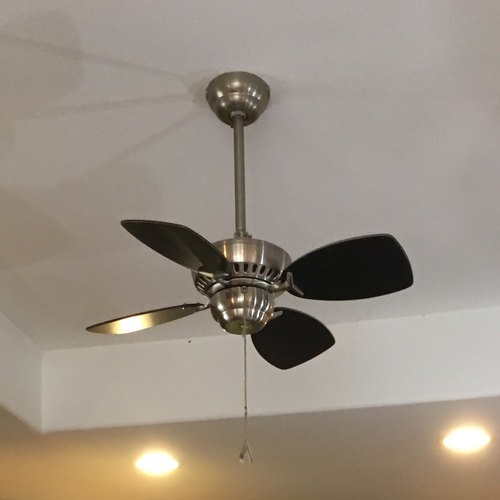
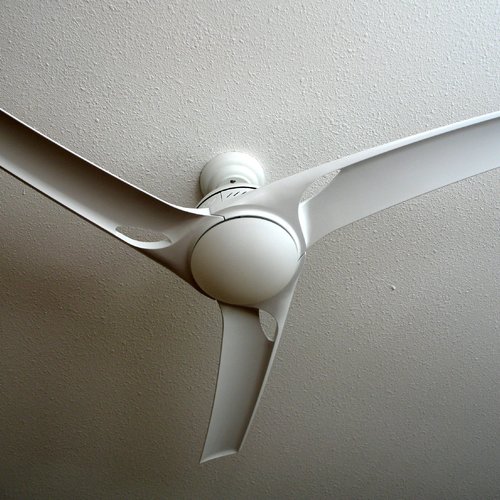
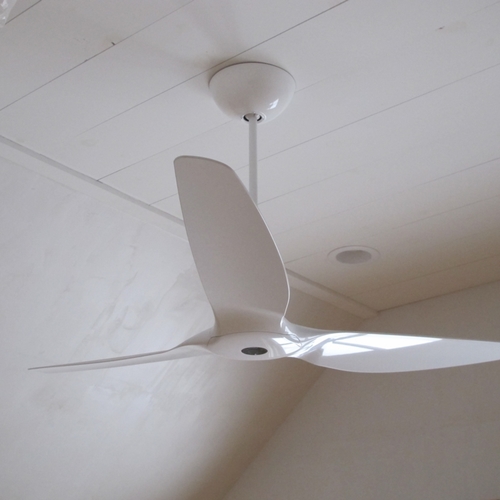
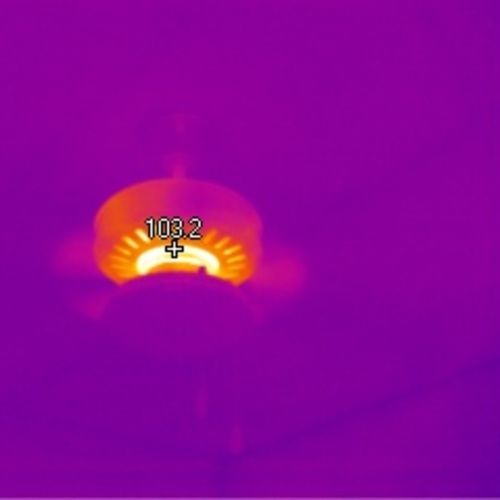






15 Comments
Increasing fan size
Here's my personal story about increasing the size of the fan too much relative to the recommendations provided by Energy Star for room size. I once installed a 52” fan in a 12’x12’x8’h bedroom, for the efficacy reasons you mention in the article. I discovered that the fan simply rotated the air in the room about the axis of the fan; where you could only feel air movement near the walls, and no air movement at all when under the fan. The problem was corrected when I installed a 44” model.
Response to Pete Marthaler
The room I installed this fan in is only slightly larger than yours and has the same ceiling height. I've been using the fan for the past few weeks and find that it does a good job distributing the air and cooling me no matter where I am in the room.
Did you notice the problem with the larger fan when it was on high, medium, and low speed? Was the smaller model the same kind of fan? Maybe it had something to do with the blades.
Flush vs Drop Rod
I had flush mounted a smaller ceiling fan once as I like the "look" of the flush mounting. The fan did not really move the air to my satisfaction. On a whim I installed it with the factory drop rod and it worked super after that. Amazing what an extra 2 or 3 inches makes............ that's what she said..... for all of you Office fans... LOL
Lighting kits, Gossamer Wind, winter fan reversal
When ENERGY STAR first started labeling ceiling fans, the primary criterion was the efficacy of the lighting kits included with them. If a fan comes with a lighting kit, it's still part of the spec: http://www.energystar.gov/index.cfm?c=ceiling_fans.pr_crit_ceiling_fans
I believe the original rationale was that kWh for lighting exceeded kWh for fan operation if fans included lights.
What's the status of the Gossamer Wind ceiling fan, developed by Danny Parker at the Florida Solar Energy Center? Still in production under a different name?
I noticed that ENERGY STAR still recommends reversing ceiling fans in winter, a tip that's been debunked over the years. Martin Holladay wrote about it (and the Gossamer Wind) in 2010:
https://www.greenbuildingadvisor.com/blogs/dept/musings/using-ceiling-fans-keep-cool-without-ac
Some of the most vehement objections I've gotten from customers have been when I suggested turning off ceiling fans in winter, or turning them off when no one's in the room in the summer. My answer to their objections is: "You can do what you want, but I'm still looking for research that documents the energy savings." If you heat with wood, I'm willing to believe that winter ceiling fan operation can improve comfort and maybe even save energy, but I haven't seen any studies.
Get Ready for the ride
Accolades to you, Allison, for taking time to research this and explaining it. This is a great example of just how silly Energy Star can be. Sorry for the long post, but we need to put this in perspective.
What's more interesting would be how much this testing costs, and how much of the purchase price is increased so that we can get an "efficiency" metric. Then it would be nice to know the assumptions around usage, and how much an "efficient" fan may actually save someone something tangible in the real world? I believe the cost savings would be somewhere in the neighborhood of zero. Of course, you'd have to offset the savings against the higher purchase price. I'd also be curious for a critique of the testing by a third party.
The sad truth is that fan makers are now going to have to spend more, precious R&D dollars, trying to chase some efficiency metric, instead of focusing on what their clients (most of us) want. They'll waste more resources trying to trick the tests so that their inferior designs may get higher test results than they should. They'll allocate personnel to lobby the agencies for their interests, instead of focusing on productivity. Precisely because they're meaningless and confusing, they'll market their results to their advantage, which will give a false credibility to the tests. Consultants will jump on board and make money on it for the same reasons. Soon we'll all be talking about ceiling fan efficiency like it's a real feature, even though it's been fabricated by the government and like entities. States will offer rebates (your money and mine) to encourage consumers to buy "efficient" fans, even though no one will save any energy costs. The fan makers will spend millions in this game, and we'll spend 100 times that through the legislation and regulation. All these things are a tax on our GDP, and all the money to pay for the tax comes out of the pocket of the consumer (you and me). Soon the lowly ceiling fan will be another notch on the proverbial belt of government for ruined appliances.
My clients buy ceiling fans based on style, color, size and price. It's a personal choice, and the assumption is that they all move quite a bit of air quietly. Most buy fans that are over sized, because they look regal and the client believes bigger is better. For the record, I also remove and dispose of quite a few fans, because people think they're an eye sore, and opt for a more stylish lighting fixture. Occasionally I run across someone who believes it will save them heating/cooling costs, but I put that folly to rest. With the exception of a joke, I couldn't fathom discussing KW/cfm with any of them.
For my applications, (moderate rooms) the standard 52" can move far more air than anyone wants. Forty-something fans may do it, but people think they look funny (too small). I'd personally be interested to know the amps (or watts) and noise level at the three speeds. I can do the math from there. The actual CFM is less interesting since you're talking convection (not transportation) of air. One would have to believe the quality of mixing is a function of the actual application, making the test even more meaningless.
I can understand how some more expensive motors, and perhaps some blade designs may result in fans that move air more efficiently. So, normalizing cfm against the power (hence W/cfm) may make sense, but I'm not sure how useful this information is. A fan that moving 10% more air for a given wattage (hence getting a higher rating) will save no money. It will likely be more noisy and pricey. I can't imagine that a fan, which consumes power, is going to save you any energy unless you happen to have a perfect alignment of circumstances. I believe it's main function is to reduce stratification by inducing convection, which increases the comfort levels (an intangible asset). BTW: we run our fans in updraft mode because we believe it's better.
Gossamer Wind
About 5 years ago, I bought a couple in the Gossamer Wind series called, I think, the Windward III. It worked fine for a couple of years, then began to hum and lose speed control. Speed control was restored by a new part (relay maybe?), but the hum has been hard to diagnose. Evaluation of fans needs to include reliability statistics.
Medium vs High Speed Efficacy
So tell me why Rem Rate asks for the CFM/Watt at medium speed and most fans are labeled for high speed? And I have to say I am disappointed that you didn't reference my post on the subject from last year: https://www.greenbuildingadvisor.com/blogs/dept/green-building-curmudgeon/ceiling-fans-are-evil
Response to Carl Seville
Carl,
Allison may not have referenced your blog, but I included it in the list of "Related Articles" in the sidebar box.
Response to Jonathan Beers
Hampton Bay makes the fan that Danny Parker and his FSEC colleagues designed. It's called the Windward IV, and you can find it in the big box stores. It's rated at 106/143/204 cfm/watt at high/med/low speeds.
Response to Gerard Celentano
Although you make it sound like the ENERGY STAR program is run by the Illuminati, you do make some good points. It's certainly worthwhile keeping this all in perspective and understanding that installing a ceiling fan isn't likely to cut your energy bills. However, having a label that allows buyers to compare the rated energy consumption different fans is a benefit.
Response to charles CAMPBELL
Yes, reliability is an important metric that's all too often ignored. There's a lot of cheap crap being sold in all categories. I installed one of the Windward fans back in '03 and lived with it for 3 years. It didn't exhibit any of the problems you describe, and I think that was the case even up till 2010, the last time I visited the house.
Response to Carl Seville
REM/Rate does what the HERS Standards say it has to do. On page 3-30, you'll see that the calculation is based on something called Labeled Ceiling Fan Standardized Watts, which is defined as "the power consumption in watts of a Labeled Ceiling Fan “standardized” to a medium speed air delivery of 3000 cfm."
As for not mentioning your article, sorry. Martin did include it in the related articles list. (By the way, I didn't complain when you didn't reference my article on the same subject from three years earlier than yours. Yeah, and why didn't I get a mention in your article Can’t Anyone Get Things Right? I've done plenty of things wrong!)
Also, you wrote about the heat given off by the motor, but that's not the only source of heat added to the room when you run a ceiling fan. Every kilowatt-hour of energy used by the fan turns into heat. So if you run a fan at 30 watts 24/7, you add 720 kWh of heat to the room each day. That converts to 2457 BTU/day, which is almost a quarter of a ton of cooling load.
Gossamer Wind Ceiling fans
Jonathan Beers,
The Gossamer Wind fans remain on the market.
Windward IV by Hampton Bay is one of them:
http://www.homedepot.com/p/Hampton-Bay-Windward-IV-52-in-Indoor-Oil-Rubbed-Bronze-Energy-Star-Ceiling-Fan-26603/202670047
An Emerson version of the same fan with a DC motor is among the most efficient.
Emerson Electric Midway ECO -- CF955WW03, CF955BS03, CF955ORB03
The 68" Altura is another model we helped with. Moves up to 8,700 cfm in operation with slow moving operation:
http://www.homedepot.com/p/Hampton-Bay-Altura-68-in-Oil-Rubbed-Bronze-Ceiling-Fan-68168/203933073?N=5yc1vZbvlq
A new model, the Evolve, should be out this summer and be more efficient than the predecessors. All the best fans in EPA's are using DC motors will will cut operating power to about a third of what it is for most fans-- albeit at a cost premium.
https://www.energystar.gov/index.cfm?c=most_efficient.me_ceiling_fans_over_52_inches
Unfortunately, the EPA website no longer shows absolute air flow and watts. Most of the best fans are using the better motors already.
One thing reading the comments: I've never recommended reversing ceiling fans in winter. The only justification might be to add a few watts more of resistance electricity to the room! I contend the only reason they can be reversed is to placate those who install the wiring backwards....Silly.
And Allison is quite correct; turn off fans when no one is around. I like them set up on a wall switch for that reason.
take the new fans out for a spin.
Gerard, I like skepticism as much as the next guy....but I encourage you to look at the specs of the different fans out there. We are not talking about 10% changes to energy usage, and your assumptions that the more efficient fans are noisier gets it backward.
I used to see fans that would make a lot of air noise spinning fast, the motor would hum and get hot (use an IR thermo) and yet I could barely feel the airflow. Now I can buy an 'efficient' fan, with properly designed (airfoil, not paddle) blades and a DC motor, and get all the air I want on a lower rotation speed, silently, using a tiny fraction of the power.
since Hampton Bay came up.....
Never again. Have you tried to get repair parts? They are not available. We have several light kits that the knuckles in the light globe stems have failed or broken---guess what? No replacement parts available. The fans have always hummed a bit and moreso at higher speeds. As needed, I've been replacing with Hunters.
Log in or create an account to post a comment.
Sign up Log in